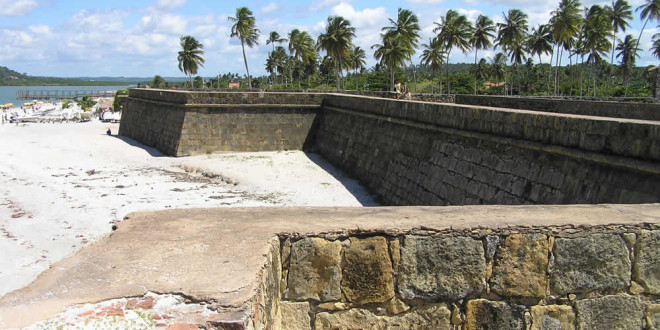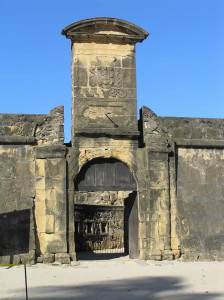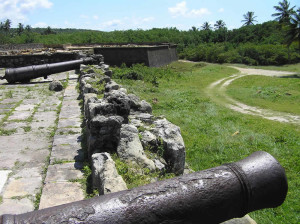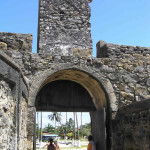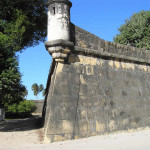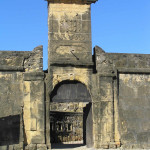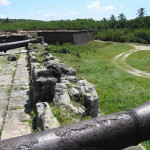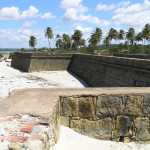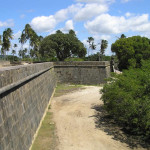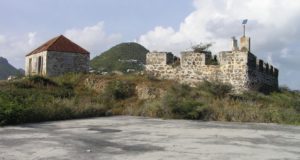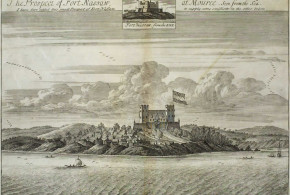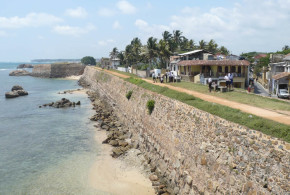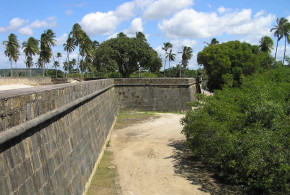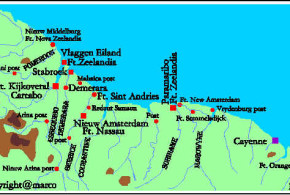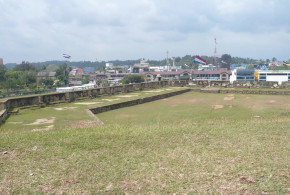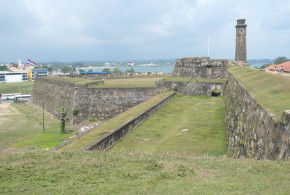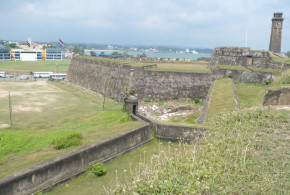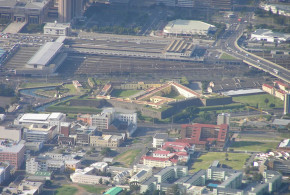Written by Marco Ramerini. English text revision by Dietrich Köster.
Fort Orange is situated 60 km north of Recife (Pernambuco). In this area the Portuguese founded a trading factory (feitoria) in 1516. On 1 September 1534 the King of Portugal created the “capitania” of Itamaracá. It was given to the donatarian Pero Lopez de Sousa. This “capitania” extended over 30 “léguas” of coast: between the Santa Cruz Canal and Baia de Traição. In this “capitania” was founded one of the first Brazilian settlements: Vila da Nossa Senhora da Conceição de Itamaracá (today Vila Velha).
Itamaracá was one of the captaincies of Portuguese Brazil. It was a small, but prosperous one. Sugar-planting was well established and it also produced tobacco, brazilwood and flax. The Brazilan North East was the richer part of the Portuguese colony of Brazil. It was the main target of the Dutch West India Company (WIC), when it decided to attack the Portuguese possession in Latin America. Recife and Olinda were the main Portuguese settlements in Pernambuco.
A Dutch fleet of 67 ships, 1,170 guns and 7,000 men under the command of Hendrick Corneliszoon Loncq arrived in Pernambuco in February 1630 and soon they attacked the Portuguese defenses. By the evening of 16 February 1630 the Dutch were in possession of Olinda and by the 3rd of March all Portuguese resistance was over and the Dutch were masters of Recife, Olinda and the island of António Vaz.
In the following year, in 1631, the Dutch decided to occupy also the island of Itamaracá. This attempt was not crowned by success. The Dutch were repelled, but returning to Recife the Lieutenant Colonel Steyen Callenfels determined that a fort with 33 cannons had to be constructed near the Canal of Santa Cruz, that separates the island from the continent, this was the main way of access to the productive areas. To dominate the entrance of the Canal meant to control the maritime access to the rich interior.
In May 1631, the Dutch built a fort named Oranje, on a little island off the southern tip of Itamaracá at the southern entrance of the Santa Cruz Canal. This fort was garrisoned by 366 men under the command of the Polish captain Crestofle d’Artischau Arciszewski. The original project of the fort was of the Dutch engineer Pieter van Bueren. The first Dutch fort was initially a earth-wooden one in square form with 4 bastions at its corners.
In June 1633 the whole island of Itamaracá was occupied by Sigismund von Schoppe. He gave his name to the small settlement, the Dutch founded there. During the Dutch occupation Itamaracá rivalled in wealth with Recife and Olinda. On 12 January 1640, in the waters near Itamaracá a Spanish-Portuguese fleet under the command of Dom Fernão de Mascarenhas, Conde da Torre, consisting of 87 ships and about 5,000 men had a series of battles with a Dutch fleet formed by 41 ships and 2,800 men and commanded by admiral Loos. The fighting lasted 5 days, during which a great deal of gunpowder was used by both sides. The battle ended without a decisive victory. In fact the Dutch lost two ships (one sunk and one driven ashore). Moreover admiral Loos was killed on the first day of fighting. On the Iberian side a big ship was lost and also 9-10 small vessels. Strategically the advantage was with the Dutch.
During the Johann Moritz of Nassau government in Brazil, the “moradores” of Itamaracá elected representatives for a legislative assembly that took place in Recife from 27 August to 4 September 1640. During the revolt, which occurred in the year 1645, the Dutch were able to repulse a Portuguese attack against the island of Itamaracá, which happened in September 1645 (20-24 September). In 1649 the fort was rebuilt of stone.
When Recife surrendered to the Portuguese forces in January 1654, the capitulation of Taborda also included places like Itamaracá and Paraíba, Rio Grande do Norte, Fernando de Noronha and Ceará, which were still in Dutch hands. The news of the Dutch surrender reached the garrison of fort Oranje on Itamaracá by an escaping Dutch official, Claes Claeszoon. Without waiting for being attacked, the garrison embarked using the available ships and fled to the West Indies. Reoccupied by the Portuguese, the fort was renamed Fortaleza de Santa Cruz.
The fortress is located by the seaside. Today it shelters a collection composed of Dutch maps and other items of the Dutch period.
- The entrance gate of Fort Orange, Itamaracá. Author and Copyright Marco Ramerini.
- A bastion of Fort Orange, Itamaracá. Author and Copyright Marco Ramerini
- The entrance gate of Fort Orange, Itamaracá. Author and Copyright Marco Ramerini.
- Cannons still mounted on a bastion, Fort Orange, Itamaracá. Author and Copyright Marco Ramerini
- Fort Orange, Itamaracá. Author and Copyright Marco Ramerini.
- Fort Orange, Itamaracá. Author and Copyright Marco Ramerini
- The beach of Fort Orange, Itamaracá, Pernambuco, Brazil. Author and Copyright Marco Ramerini
BIBLIOGRAPHY:
– Various Authors “Tempo dos Flamengos e outros tempos. Brasil século XVII” 351 pp. Fundação Joaquim Nabuco – Editora Massangana, 1999, Recife, Brasil. Seminário Internacional em comemoração aos 500 anos do descobrimento.
– Barlaeus, Gaspar “História dos feitos recentemente praticados durante oito anos no Brasil” Prefácio de José António Gonçalves de Mello. Fundação de Cultura Cidade do Recife, 1980, Recife, Brazil. – Bezerra, Rubens Borges “Moedas holandesas em Pernambuco, Dutch coins in Pernambuco” 136 pp. ills. Gráf. Editora, 1980, Recife, Brazil.
– Boxer, Ch. R. “The Dutch in Brazil 1624-1654” xiii, 327 pp. 4 maps Oxford University Press 1957 London, United Kingdom
– Boxer, Ch. R. “Salvador de Sá and the struggle for Brazil and Angola, 1602-1686” xvi, 444 pp. The Athlone Press 1952 London, United Kingdom
– Brienen, R. P: “Georg Marcgraf (1610-c. 1644) a German Cartographer, Astronomer and Naturalist-Illustrator in Colonial Dutch Brazil” In: “Itinerario” 1/2001 pp. 85-122
– Cabral de Mello, E. “Olinda restaurada guerra e açucar no Nordeste 1630 – 1654” 470 pp. Topbooks Editora, 2° ed. 1998, Rio de Janeiro, Brasil
– Di Pace, Vittorio “Napoletani in Brasile nella guerra di liberazione dall’invasione olandese : 1625-1640” 129 pp. [42] c. tav. ills. Casa Editrice Fausto Fiorentino, 1991, Napoli.
– Edmundson “The Dutch power in Brazil. The first conquest” English historical review: 1899 Vol. XIV 676 – 699 pp.
– Galvão, Sebastião de Vasconcellos “Expulsão dos Holandeses de Pernambuco” Tomo Especial, ICHN, V. 5, 1915, p. 371-420.
– Girão, Raimundo “Matias Beck, fundador de Fortaleza” 168 pp. Imprensa Oficial do Ceará, 1961, Fortaleza, Ceará, Brasil.
– Gonçalves de Mello, J. A. Neto “Tempo dos Flamengos: influência da ocupação holandesa na vida e na cultura do Norte do Brasil” 337 pp. José Olympio, 1947, Rio de Janeiro, Brazil.
– Krommen, Rita “Mathias Beck e a Cia. das Índias Ocidentais: o domínio holandês no Ceará colonial” 310 pp. illust. Casa de José de Alencar, 1997 1. ed., Fortaleza, Brasil.
– Lima, Felício “Expulsão dos holandeses do Brasil” Conferência pronunciada no Círculo de Oficiais Reformados do Exército e da Armada do Brasil, 16 de Abril de 1948
– Moreira Bento, Cláudio “As guerras holandesas 1624-1654” Internet article, “Comemorativo do 350° aniversário em 19 de Abril de 1998 da vitória luso-brasileira na 1° Batalha dos Montes Guararapes, no Recife em Pernambuco/Brasil”
– Nederveen Meerkerk, H. van “Recife. The rise of a 17th-century trade city from a cultural-historical perspective” 459 pp. ills. van Gorcum, 1989, Assen-Maastricht, Netherlands.
– van der Straaten, Harald S. “Brazil – A Destiny: Dutch Contacts through the Ages” 164 pp. Government Publishing Office, 1984, The Hague, Netherlands.
 Colonial Voyage The website dedicated to the Colonial History
Colonial Voyage The website dedicated to the Colonial History
